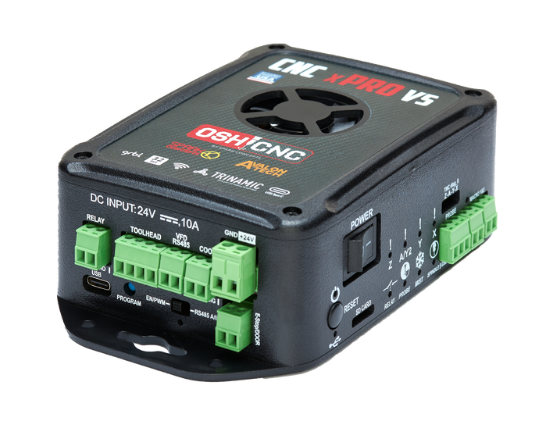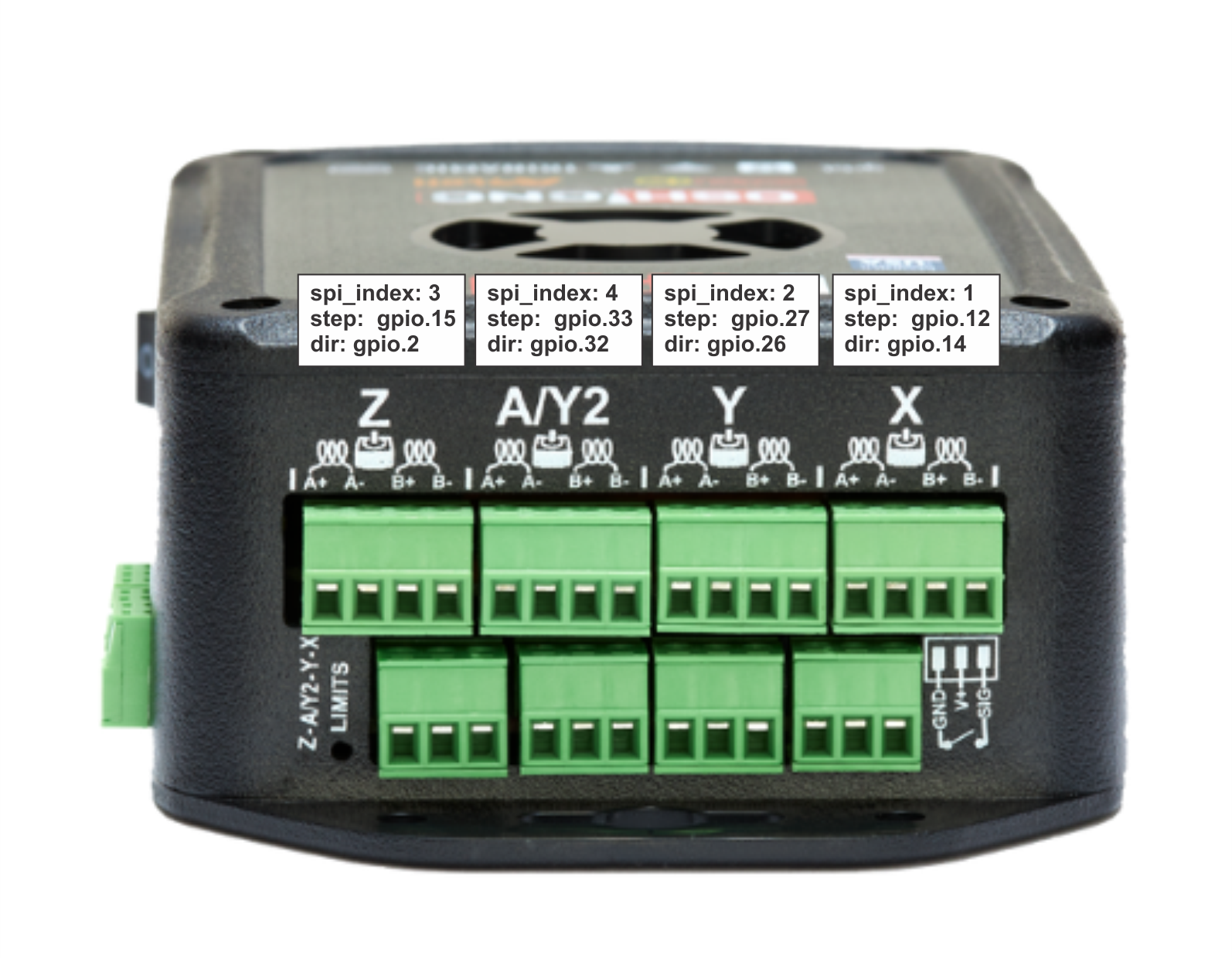
¶ Overview
This page is to share information helpful when using FluidNC on the Spark Concepts xPro V5. Your first line of support should be directly with the supplier. They also have a wiki. We cannot guarantee this is accurate and mistakes could damage your controller.
¶ Stepper Driver Pinout
The controller uses Trinamic TMC5160 stepper motor drivers. The drivers are set up and controlled by the firmware using a daisy chained SPI bus shared with the SD card. It uses the default SPI pinout for FluidNC.
spi:
miso_pin: gpio.19
mosi_pin: gpio.23
sck_pin: gpio.18
- The
cs_pin:isgpio.17and should be defined under the first motor. - There are no enable pins. You should set
use_enable: trueon each axis.
The labels for the motors are suggestions only. You can use any driver for any axis or motor(0/1) you want. The things that you cannot change are shown in the notes in the graphic below. For example: the terminal block labeled Y can be anything, but whatever you assign it to, that driver must use spi_idex: 2, etc.
NOTE: Due to the way SPI daisy chain works, you must have a motor with spi_index: 4. This insures data is pushed through the whole daisy chain. For example: if you only want to use 2 axes, one must be spi_index: 4 (labeled A/Y2).

¶ Other Pins
XLimit: gpio.35
YLimit: gpio.34
ZLimit: gpio.39
A/Y2Limit: gpio.36
Probe: gpio.22
Mist: gpio.21
Door: gpio.16
Macro1: gpio.13
Macro2: gpio.0
Spindle Enable or RS485RX: gpio.4
Spindle PWM Output or RS485TX: gpio.25
SPI SCK: gpio.18
SPI MISO: gpio.19
SPI MOSI: gpio.23
SDCard CS: gpio.5
TMC CS: gpio.17
¶ Programming
The xPro V5's circuitry for entering programming mode based on signals from the USB serial chip is not the same as on most Espressif modules. If you have trouble with programming with the FluidNC installer or esptool, you can manually force it into programming mode:
- Press and hold the Reset button
- While holding Reset, press and hold the Program button
- Release the Reset button
- Release the Program button
Then it will be in programming mode and you can run the installer or esptool to program the ESP32.
¶ Example Config File
board: XPro V5
name: xPro V5 XYZA
stepping:
engine: RMT
idle_ms: 255
pulse_us: 2
dir_delay_us: 1
disable_delay_us: 0
axes:
shared_stepper_disable_pin: NO_PIN
x:
steps_per_mm: 200.000
max_rate_mm_per_min: 5000.000
acceleration_mm_per_sec2: 100.000
max_travel_mm: 300.000
soft_limits: false
homing:
cycle: 2
positive_direction: false
mpos_mm: 150.000
feed_mm_per_min: 100.000
seek_mm_per_min: 200.000
settle_ms: 500
seek_scaler: 1.100
feed_scaler: 1.100
motor0:
limit_neg_pin: gpio.35:low
limit_pos_pin: NO_PIN
limit_all_pin: NO_PIN
hard_limits: false
pulloff_mm: 1.000
tmc_5160:
step_pin: gpio.12
direction_pin: gpio.14
use_enable: true
cs_pin: gpio.17
spi_index: 1
r_sense_ohms: 0.050
run_amps: 1.800
hold_amps: 1.250
microsteps: 8
toff_disable: 0
toff_stealthchop: 5
run_mode: CoolStep
homing_mode: CoolStep
stallguard: 16
stallguard_debug: false
toff_coolstep: 3
tpfd: 4
y:
steps_per_mm: 200.000
max_rate_mm_per_min: 5000.000
acceleration_mm_per_sec2: 100.000
max_travel_mm: 300.000
soft_limits: false
homing:
cycle: 2
positive_direction: false
mpos_mm: 150.000
feed_mm_per_min: 100.000
seek_mm_per_min: 200.000
settle_ms: 500
seek_scaler: 1.100
feed_scaler: 1.100
motor0:
limit_neg_pin: gpio.34:low
limit_pos_pin: NO_PIN
limit_all_pin: NO_PIN
hard_limits: false
pulloff_mm: 1.000
tmc_5160:
step_pin: gpio.27
direction_pin: gpio.26
use_enable: true
cs_pin: NO_PIN
spi_index: 2
r_sense_ohms: 0.050
run_amps: 1.800
hold_amps: 1.250
microsteps: 8
toff_disable: 0
toff_stealthchop: 5
run_mode: CoolStep
homing_mode: CoolStep
stallguard: 16
stallguard_debug: false
toff_coolstep: 3
tpfd: 4
z:
steps_per_mm: 200.000
max_rate_mm_per_min: 5000.000
acceleration_mm_per_sec2: 100.000
max_travel_mm: 300.000
soft_limits: false
homing:
cycle: 2
positive_direction: false
mpos_mm: 150.000
feed_mm_per_min: 100.000
seek_mm_per_min: 200.000
settle_ms: 500
seek_scaler: 1.100
feed_scaler: 1.100
motor0:
limit_neg_pin: gpio.39:low
limit_pos_pin: NO_PIN
limit_all_pin: NO_PIN
hard_limits: false
pulloff_mm: 1.000
tmc_5160:
step_pin: gpio.15
direction_pin: gpio.2
use_enable: true
cs_pin: NO_PIN
spi_index: 4
r_sense_ohms: 0.050
run_amps: 1.800
hold_amps: 1.250
microsteps: 16
toff_disable: 0
toff_stealthchop: 5
run_mode: CoolStep
homing_mode: CoolStep
stallguard: 16
stallguard_debug: false
toff_coolstep: 3
tpfd: 4
a:
steps_per_mm: 200.000
max_rate_mm_per_min: 5000.000
acceleration_mm_per_sec2: 100.000
max_travel_mm: 300.000
soft_limits: false
homing:
cycle: 2
positive_direction: false
mpos_mm: 150.000
feed_mm_per_min: 100.000
seek_mm_per_min: 200.000
settle_ms: 500
seek_scaler: 1.100
feed_scaler: 1.100
motor0:
limit_neg_pin: gpio.36:low
limit_pos_pin: NO_PIN
limit_all_pin: NO_PIN
hard_limits: false
pulloff_mm: 1.000
tmc_5160:
step_pin: gpio.33
direction_pin: gpio.32
use_enable: true
cs_pin: NO_PIN
spi_index: 3
r_sense_ohms: 0.050
run_amps: 1.800
hold_amps: 1.250
microsteps: 16
toff_disable: 0
toff_stealthchop: 5
run_mode: CoolStep
homing_mode: CoolStep
stallguard: 16
stallguard_debug: false
toff_coolstep: 3
tpfd: 4
spi:
miso_pin: gpio.19
mosi_pin: gpio.23
sck_pin: gpio.18
sdcard:
card_detect_pin: NO_PIN
cs_pin: gpio.5
probe:
pin: gpio.22:low
check_mode_start: true
control:
safety_door_pin: gpio.16:low
macro0_pin: gpio.13:low
macro1_pin: gpio.0:low
macros:
startup_line0:
startup_line1:
macro0:
macro1:
macro2:
macro3:
start:
must_home: false
coolant:
mist_pin: gpio.21
delay_ms: 0
¶ Spindles
The XPro-V5 documentation explains how to hook up different types of spindles. That documentation uses Grbl_ESP32 configuration commands, but FluidNC configuration is different, as detailed below.
The old Grbl_ESP32 firmware has a $Spindle/Type=value setting to select which spindle to use. The values include "NONE", "PWM", "Laser", "HUANYANG", and "H2A". Instead of $Spindle/Type, FluidNC has a section in the config.yaml file that selects the spindle and sets it parameters. See this information for configuring FluidNC spindles
The thing you need to know that is specific to XPro-V5 is the pin numbers for controlling the spindle. For controlling Laser, PWM, and 10V spindles, you need "output_pin: gpio.25" and "enable_pin: gpio.4" in the spindle section, like this:
10V:
output_pin: gpio.25
enable_pin: gpio.4
The section name is not necessarily "10V:"; it could be "Laser:" or "PWM:" depending on your machine.
For RS485 VFD type spindles, you need "txd_pin: gpio.4", "rxd_pin: gpio.25", and "rts_pin: NO_PIN".
Unless you are an expert, you are better off using 0-10V control for VFD spindles, instead of RS485 control. RS485 can be very difficult to get working reliably.
¶ Huanyang VFD Spindle Example
uart1:
txd_pin: gpio.4
rxd_pin: gpio.25
rts_pin: NO_PIN
baud: 9600
mode: 8N1
huanyang:
uart_num: 1
modbus_id: 1
tool_num: 0
speed_map: 0=0% 0=25% 6000=25% 24000=100%
off_on_alarm: false
¶ Known Problems
XProV5 is a commercial product so your first line of support should be the vendor; that said, here are a couple of things that might come up:
- Dead Y Axis - there appears to be a recurring problem with fried Y axis drivers
- RS485/VFD Spindle Hookup - Some people have ground loop problems with RS485 hookup. Adding a repeater seems to help.